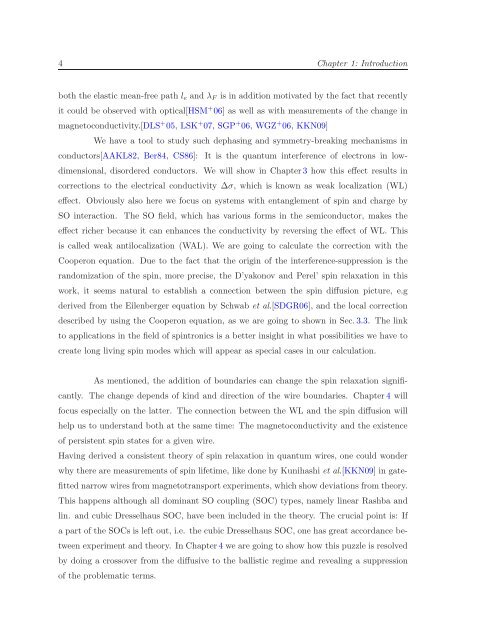Itinerant Spin Dynamics in Structures of ... - Jacobs University
Itinerant Spin Dynamics in Structures of ... - Jacobs University
Itinerant Spin Dynamics in Structures of ... - Jacobs University
You also want an ePaper? Increase the reach of your titles
YUMPU automatically turns print PDFs into web optimized ePapers that Google loves.
4 Chapter 1: Introduction<br />
both the elastic mean-free path l e and λ F is <strong>in</strong> addition motivated by the fact that recently<br />
it could be observed with optical[HSM + 06] as well as with measurements <strong>of</strong> the change <strong>in</strong><br />
magnetoconductivity.[DLS + 05, LSK + 07, SGP + 06, WGZ + 06, KKN09]<br />
We have a tool to study such dephas<strong>in</strong>g and symmetry-break<strong>in</strong>g mechanisms <strong>in</strong><br />
conductors[AAKL82, Ber84, CS86]: It is the quantum <strong>in</strong>terference <strong>of</strong> electrons <strong>in</strong> lowdimensional,<br />
disordered conductors. We will show <strong>in</strong> Chapter3 how this effect results <strong>in</strong><br />
corrections to the electrical conductivity ∆σ, which is known as weak localization (WL)<br />
effect. Obviously also here we focus on systems with entanglement <strong>of</strong> sp<strong>in</strong> and charge by<br />
SO <strong>in</strong>teraction. The SO field, which has various forms <strong>in</strong> the semiconductor, makes the<br />
effect richer because it can enhances the conductivity by revers<strong>in</strong>g the effect <strong>of</strong> WL. This<br />
is called weak antilocalization (WAL). We are go<strong>in</strong>g to calculate the correction with the<br />
Cooperon equation. Due to the fact that the orig<strong>in</strong> <strong>of</strong> the <strong>in</strong>terference-suppression is the<br />
randomization <strong>of</strong> the sp<strong>in</strong>, more precise, the D’yakonov and Perel’ sp<strong>in</strong> relaxation <strong>in</strong> this<br />
work, it seems natural to establish a connection between the sp<strong>in</strong> diffusion picture, e.g<br />
derived from the Eilenberger equation by Schwab et al.[SDGR06], and the local correction<br />
described by us<strong>in</strong>g the Cooperon equation, as we are go<strong>in</strong>g to shown <strong>in</strong> Sec.3.3. The l<strong>in</strong>k<br />
to applications <strong>in</strong> the field <strong>of</strong> sp<strong>in</strong>tronics is a better <strong>in</strong>sight <strong>in</strong> what possibilities we have to<br />
create long liv<strong>in</strong>g sp<strong>in</strong> modes which will appear as special cases <strong>in</strong> our calculation.<br />
As mentioned, the addition <strong>of</strong> boundaries can change the sp<strong>in</strong> relaxation significantly.<br />
The change depends <strong>of</strong> k<strong>in</strong>d and direction <strong>of</strong> the wire boundaries. Chapter4 will<br />
focus especially on the latter. The connection between the WL and the sp<strong>in</strong> diffusion will<br />
help us to understand both at the same time: The magnetoconductivity and the existence<br />
<strong>of</strong> persistent sp<strong>in</strong> states for a given wire.<br />
Hav<strong>in</strong>g derived a consistent theory <strong>of</strong> sp<strong>in</strong> relaxation <strong>in</strong> quantum wires, one could wonder<br />
why there are measurements <strong>of</strong> sp<strong>in</strong> lifetime, like done by Kunihashi et al.[KKN09] <strong>in</strong> gatefitted<br />
narrowwiresfrommagnetotransport experiments, whichshowdeviations fromtheory.<br />
This happens although all dom<strong>in</strong>ant SO coupl<strong>in</strong>g (SOC) types, namely l<strong>in</strong>ear Rashba and<br />
l<strong>in</strong>. and cubic Dresselhaus SOC, have been <strong>in</strong>cluded <strong>in</strong> the theory. The crucial po<strong>in</strong>t is: If<br />
a part <strong>of</strong> the SOCs is left out, i.e. the cubic Dresselhaus SOC, one has great accordance between<br />
experiment and theory. In Chapter4 we are go<strong>in</strong>g to show how this puzzle is resolved<br />
by do<strong>in</strong>g a crossover from the diffusive to the ballistic regime and reveal<strong>in</strong>g a suppression<br />
<strong>of</strong> the problematic terms.
















